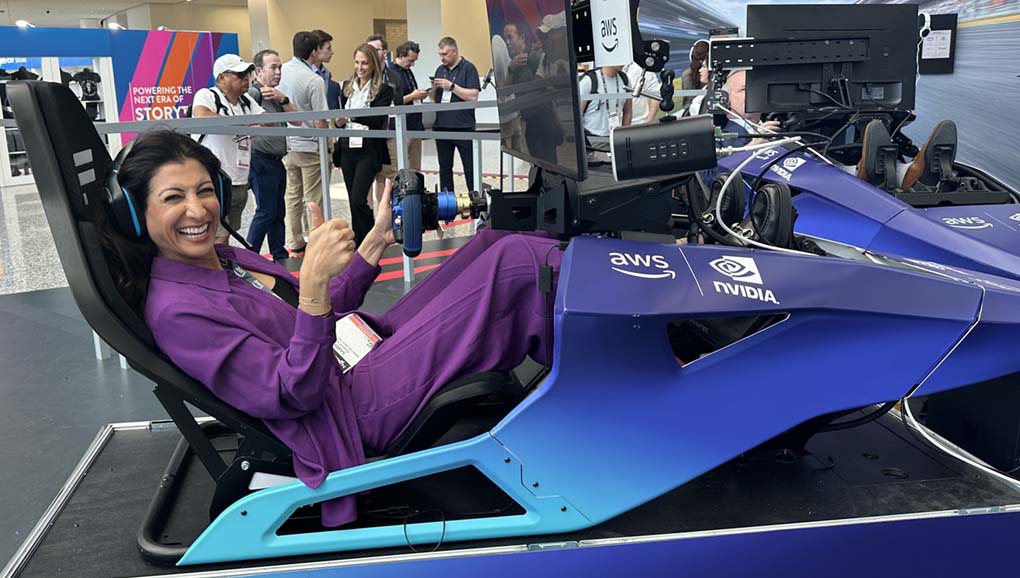Cloud-Based Live Production Is Right Here and Right Now
2025 NAB Show illustrates how the technology is ‘no longer an experiment’

With more broadcasters moving to cloud-based live production worldwide, this year’s NAB Show was further proof that the technology is now recognized and proven. Manufacturers and developers are progressing with new systems that run on this framework, offering broadcasters greater functionality and flexibility for producing coverage of live events.
“Cloud production remains not only current technology but also future technology in the realm of live production,” says Deon LeCointe, director of networked solutions with Sony Electronics. At NAB Show, Sony highlighted its M2 Live (M2L) multipoint-to-multipoint live production switcher, available as both a subscription-based version and in software form (the M2L-X).
“New features are being introduced for both of those products and we demonstrated integrations with on-prem hardware like audio consoles,” LeCointe says. “We’re also continuing to see a growing interest from a lot of our clients in what we call ‘hybrid production,’ the idea of mixing an on-prem hardware switcher with cloud-based or virtualized production resources.”
‘This Stuff is Real’
Costa Nikols, strategy adviser for media and entertainment at Telos Alliance, agrees that this way of working has become an established part of how broadcasting is done today. “The fact that cloud-based production is no longer an experiment was definitely one of the big takeaways this year,” he says.

Nikols says more broadcasters see cloud as a mature technology: “This year the attitude is ‘this stuff is real.’ They’re generating programs and revenue out of it.” The other significant takeaway, he adds, revolved around the Trump administration’s proposed tariffs, which, while firmly a commercial problem, seem to also be making a technological impact.
“We spent hours talking to people about this situation and the outcome was that they are seeing software, which could be licensable on an edge device, or containerized and virtualized or running in the public cloud, as less vulnerable to tariff penalties.”
Jamie Dunn, deputy chief executive of Lawo, also acknowledges the growth in software-based systems, which, linked to the adoption of IT technologies, is bringing greater flexibility to production.
The professional video industry's #1 source for news, trends and product and tech information. Sign up below.
“Sometimes when people talk about the cloud, everything gets merged into one topical cloud when it’s really multiple things,” he says. “The cloud is more about agile infrastructure, which is an important topic right now and is partly driven by the move towards software and processing on standard IT technology.”
Dunn adds that the transition to IP over the past five to six years is not the significant aspect of this development but rather where it is heading. “The destination is the exciting part because it will give the flexibility to address the commercial issues,” he says. “This means having the agility to generate more content given the changes in viewing habits over the last few years.”
More Subscription Flexibility
Other companies have continued to explore this now key element of cloud operations, with Ross Video previewing its Cloud Provisioning Service at the show. Gary Green, vice president of cloud for Ross, explains that this is designed to quickly deploy all the infrastructure and applications necessary for an end-to-end live production.
“Cloud resources are very expensive, so if you’re not using them, you want to be able to stop them and not be paying your provider when you no longer need that service,” he says. “The Provisioning Tool lets you get the environment installed ready to be configured and up and running.”
Ross’s cloud offering has also been extended through its Rocket Surgery Virtual Productions group. This is now running Rocket Cloud Services, which, Green explains, “provides better graphics capabilities” for on-premise productions, with a major user being the Big Ten Network.
At NAB Show, TVU Networks demoed new advanced features for its cloud-based Media Hub platform, designed to transform media supply chain management. The company has taken a collaborative approach to its cloud strategy, which was demonstrated in its work supporting France Télévisions’ broadcast of the Paris Summer Games Torch Relay last year. In recognition, the company garnered the 2025 NAB Show Project of the Year Award.
Host broadcaster France Télévisions enhanced its coverage in Paris using cloud technology, private 5G and Starlink to cut costs, reduce carbon dioxide emissions and enhance production. It was the first 100% cloud-based end-to-end 5G live production and disaster recovery plan for a tier-1 sporting event, according to the company.
The ambitious project resulted in historic outcomes: nearly 60 million views in France, a 96% drop in transmission costs, 63% savings in production expenses, and over 600 metric tons of CO2 saved.
“It’s about working together, challenging what we accept as possible,” says Paul Shen, CEO of TVU Networks, emphasizing the collaborative effort in turning visions into reality. “This isn’t just a milestone; it’s a wake-up call to the industry. The future of broadcast is here, and it’s accessible, sustainable, and opens up endless possibilities for bringing more content to fans everywhere.”
More Partnerships
The need for greater interconnectivity and collaboration was reflected in announcements and demonstrations by Amazon Web Services (AWS). There was a significant move forward in the Cloud Native Agile Production (CNAP) project, an open-source initiative aimed at accelerating the creation and delivery of media during live production.
Initial technology partners BBC R&D, Sky, CuttingRoom and Adobe were joined at the show by other broadcasters and sports production organizations, including the NHL. “We saw that really take shape and generate more momentum as we came into the NAB Show,” says Samira Bakhtiar, general manager of media and entertainment, games and sports business at AWS.
The company also announced NDI support for the AWS Elemental Media Connect video transport platform and SMPTE ST 2110 support of several of its hybrid workloads.
“The industry had been asking for both of these,” Bakhtiar says. “It is also part of our investment in the Elemental Media Service portfolio.
“But the main trend we’re seeing is the rapid advancement and availability of cloud services, Generative AI and AI services being paired with purpose-built services for media, entertainment and gaming,” she adds. “The amalgamation of these things is allowing for new companies, like startups, or more established firms such as Epic, to be able
to get to market faster with new products.” GenAI was demonstrated at the AWS booth to create agentic workflows to facilitate quality control, clip creation and summarization for video production.
Cloud production may not yet be universal yet, but if NAB Show is any indication, it is gaining in popularity as broadcasters see its benefits both operationally and financially.
Kevin Hilton has been writing about broadcast and new media technology for nearly 40 years. He began his career a radio journalist but moved into magazine writing during the late 1980s, working on the staff of Pro Sound News Europe and Broadcast Systems International. Since going freelance in 1993 he has contributed interviews, reviews and features about television, film, radio and new technology for a wide range of publications.
